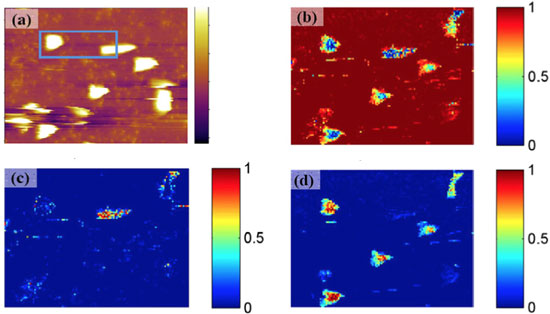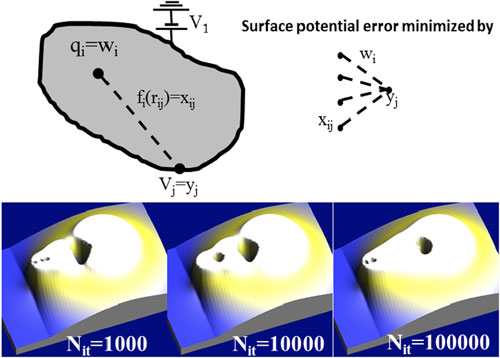| Posted: Oct 15, 2013 | |
Artificial intelligence (AI) in nanotechnology research |
|
| (Nanowerk Spotlight) The debate about 'converging technologies' is part of a more comprehensive political and social discourse on nanotechnology, biotechnology, information and communications technology (ICT), brain research, artificial intelligence (AI), robotics, and the sciences that deal with these topics. Convergence is an umbrella term for predictions ranging from an increase in synergetic effects to a merging of these fields, and for demands for government funding of research and development where these fields overlap (read more in our Nanowerk Spotlight: "The debate about converging technologies"). | |
| While nanotechnology combines the knowledge of physics, chemistry and engineering, AI has heavily relied on biological inspiration to develop some of its most effective paradigms such as neural networks or evolutionary algorithms. Bridging the link between current nanosciences and AI can boost research in these disciplines and provide a new generation of information and communication technologies that will have a large impact in our society, probably providing the means so that technology and biology merge. | |
| A new review paper in Nanotechnology ("Artificial intelligence in nanotechnology") addresses some of the relevant questions in this context: how can nanotechnology further benefit from computational intelligence developments, and how can nanotechnology be of use to implement novel AI paradigms, possibly expanding their uses and merging the gap to biotechnology? | |
| As the authors – Sacha Gomez and Pablo Varona from the Grupo de Neurocomputación Biológica at the Universidad Autónoma de Madrid – point out, there are several reasons why AI paradigms are being used in nano research: "Nanotechnology suffers the physical limitations of its working scale, where the physics is completely different from that of the macroscopic world. This means that the correct interpretation of the results obtained from any system or device at this scale is one of the issues that must be faced in nanotechnology. To make the scenario even worse, it is frequent to find systems where many elements have a strong influence in the signal. In these cases, the development of analytical approximations is hard, and numerical simulations have become widely used to obtain accurate interpretations of experimental results. It is in this context that AI tools such as machine learning paradigms can play a key role in producing scientific results as well as in the development of future nano applications." | |
| Gomez and Varona discuss several examples of the use and application of artificial intelligence tools in nanotechnology research: | |
| AI in scanning probe microscopy (SPM) | |
| Although many efforts have been made in the last years to improve the resolution and the ability to manipulate atoms, the interpretation of the microscope signal is still a challenge. The main problem is that most of the tip–sample interactions are not easy to understand and depend on many parameters. These are the kinds of problems where methods from artificial intelligence can be extremely helpful. | |
| Recently there has been great progress in multimodal SPM imaging in which multiple channels are acquired at the same time providing important complementary information about the image. Examples include dual excitation frequency SPM, multiple harmonic imaging, 3D-modes, band excitation SPM and the use of rapid digital lock-ins. This huge amount of information rapidly increases the difficulty of interpreting specific properties of the material. | |
| To tackle this issue, researchers introduced a SPM approach ("Functional recognition imaging using artificial neural networks: applications to rapid cellular identification via broadband electromechanical response "), called functional recognition imaging (FR-SPM), which looks for direct recognition of local behaviors from measured spectroscopic responses using neural networks trained on examples provided by an expert. This technique combines the use of artificial neural networks (ANNs) with principal component analysis (PCA), which is used to simplify the input data to the neural network by whitening and decorrelating the data, reducing the number of independent variables. | |
 |
|
| Identification of bacteria on a PLL-coated mica substrate with ANN. (a) Topography image of the bacteria on PLL mica (the area within the blue rectangle was used for training the neural net). Output of the neural net in the form of recognition maps for the background (b), P. fluorescens (c) and M. lysodeikticus (d). Value 0 corresponds to the minimum likelihood of the point being the target when value 1 corresponds to the maximum. (© IOP Publishing) | |
| Classification of material properties at the nanoscale | |
| Characterization of the structural properties of nanomaterials has also been solved by the use of ANNs. For example, these algorithms have been employed to determine the morphology of carbon nanotube turfs by quantifying structural properties such as alignment and curvature. Other examples: | |
| The characterization of different properties of thin films is a problem that has been widely solved by using neural networks. Because of the nonlinearities in the analysis of the signal in a film–substrate system, it is appropriate to use ANNs to process such complex systems. | |
| The determination of material properties of functionally graded materials (FMG) assisted by ANNs has also been reported. | |
| An ANN model has also been developed to accurately obtain physical characteristics of quantum-dot semiconductor optical amplifiers such as pulse amplification and four-wave mixing characteristics. | |
| Optical properties have been widely analyzed by AI techniques for two main reasons. First, the fast growth of broadband communications, multimedia and the Internet is closely related to the use of optical networks. Second, as the complexity of this kind of system increases, AI becomes an extremely useful tool. | |
| Chemical reactions are another field where several works have studied the advantages of using AI methods as classification tools. For instance, it has been demonstrated that ANNs can evaluate chemical kinetic data parameters such as rate constants or concentrations of the reactants. | |
| AI techniques have begun to be used for the formulation of the properties and performance of concrete. For example, ANNs and GAs have been used to predict the splitting tensile strength and water absorption values of concretes containing ZnO2 or Cr2O3 nanoparticles. | |
| Designing nanosystems | |
| ANNs have been used to explore the nonlinear relationship between input variables and output responses in the deposition process of transparent conductive oxide. | |
| Evolutionary optimization has also been used to find improved nanoantenna structures. | |
| The focusing quality of integrally gated CNT field-emission devices have been optimized by numerical methods that include genetic algorithms (GAs). | |
| Genetic algorithms are very well established in radio frequency antenna engineering because they can be easily implemented and because of their effective use of parallelism. | |
| In the last few years, GAs have also found application in the field of nano-optics. For example, one method for designing plasmonic particles with desired resonance spectra exploits the interaction of local geometry with surface charge distribution and applies an evolutionary algorithm. | |
| Artificial intelligence in nanoscale simulations | |
| One of the main problems that scientists must face when working at the nanoscale is related to the simulation of the system under study. The difference between macroscopic and nanoscopic images is that real optical images cannot be obtained at the nanoscale. Images at this scale must be interpreted and numerical simulations are sometimes the best solution. | |
| At this time, there are many programs and applications that accurately simulate different systems where atomic effects are present. When they are correctly employed, these techniques are extremely useful to get a precise idea of what is present in the image. However, in many cases they are still difficult to use and many parameters must be taken into account to obtain an accurate representation of the system. In this context, AI can be useful to improve the quality of the simulations and to make them easier to obtain and interpret. | |
 |
|
| Schematic representation of the numerical method used to simulate the electrostatic potential around metallic objects and the ANN routine used to minimize the error at the surface. Equipotential distributions of an atomic force microscopy tip over a dielectric sample are also shown as a function of the ANN iterations. (© IOP Publishing) | |
| A second application of ANNs in simulation software is to reduce the complexity associated with its configuration. In many numerical simulation methods there is a great number of parameters that must be fitted to create the optimal configuration for an accurate simulation of the system. Most of these parameters are related to the physical geometry of the system, and must be known by the user. However, other kinds of parameters are only related to the algorithms used in the simulation and only users with an expertise in numerical methods are able to correctly manage them. This fact strongly reduces the usability of the software. To overcome this problem, ANNs have been proposed as a method to be included in the simulation packages with the objective of finding an adequate configuration automatically. | |
| Nanocomputing and artificial intelligence | |
| Beyond solving problems in nanoscale microscopy, nanomaterial science and nanoscale simulation, there is a variety of potential applications arising from the combination of AI and present and future nanocomputing, i.e. computation done with nanodevices. Overall, there is a wide variety of emerging nanotechnologies to implement nanocomputing devices, some of which are bio-inspired (like DNA computing). These technologies, by adding novel physical bases of operation (photon, plasmon, molecular state, etc), reconfigurable architectures, memory and computational principles, will be able to use novel data representations to implement machine learning paradigms to solve complex problems in a wide variety of applications. | |
| Concluding their review, the two authors emphasize that bridging the gap between nanotechnology and AI can lead to a more effective interaction between brains and machines and in fact provide the means for technology and biology to merge. | |
 By
Michael
Berger
– Michael is author of three books by the Royal Society of Chemistry:
Nano-Society: Pushing the Boundaries of Technology,
Nanotechnology: The Future is Tiny, and
Nanoengineering: The Skills and Tools Making Technology Invisible
Copyright ©
Nanowerk LLC
By
Michael
Berger
– Michael is author of three books by the Royal Society of Chemistry:
Nano-Society: Pushing the Boundaries of Technology,
Nanotechnology: The Future is Tiny, and
Nanoengineering: The Skills and Tools Making Technology Invisible
Copyright ©
Nanowerk LLC
|
|
|
Become a Spotlight guest author! Join our large and growing group of guest contributors. Have you just published a scientific paper or have other exciting developments to share with the nanotechnology community? Here is how to publish on nanowerk.com. |
|
